The first thing I did during my tryout for the sailing team was crash straight into the seawall. Everyone at the Naval Academy is required to be part of a sports team. I did track in high school, but there was no way I was making the team at the Academy, and I was forced to shop around for alternatives. My dad owned a sailboat so I knew how to make a sailboat go in about the right direction, and I thought I would give the sailing team a try. Like all boats, however, my dad’s boat had spent more time in port than out, so my several cumulative days’ worth of experience did not justify the overconfidence which drove me straight into the side of Dewey basin. I had only distinguished myself by being the one candidate who followed the directions by wearing the standard-issue boat shoe socks, and was allowed onto the team.
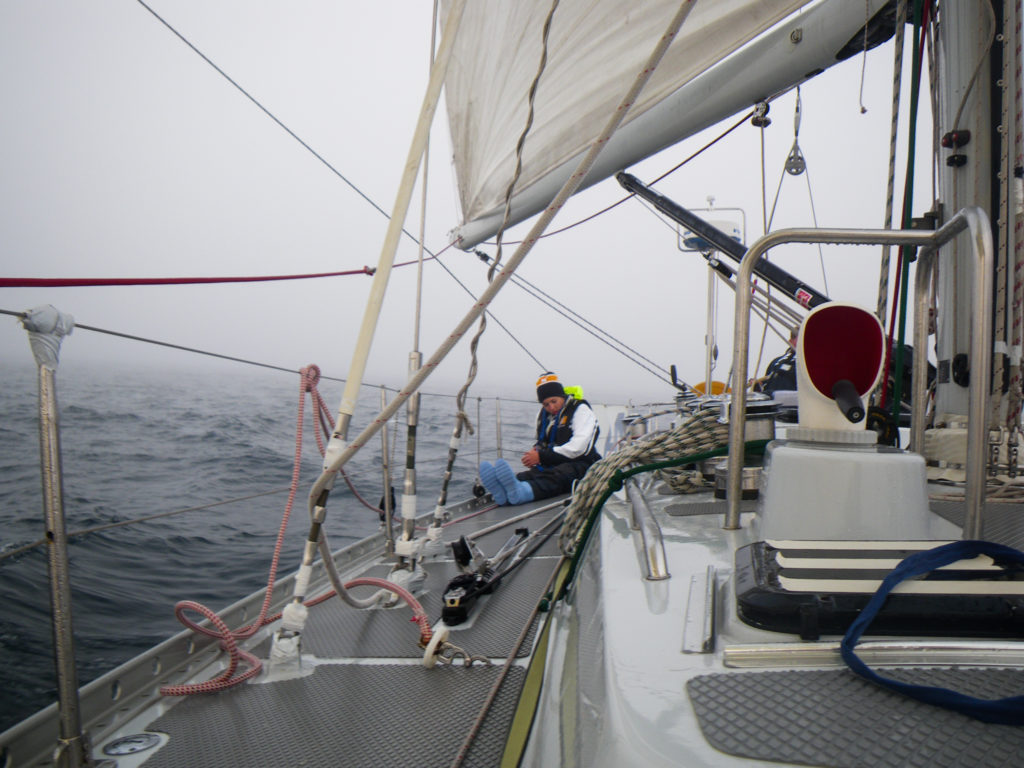
I would learn on my next three years on the sailing team that sailing isn’t about ships, it’s about the sea. Mariners obsess over their ships. They tune the rigging and paint the sides and mend the sails and splice the lines. Given the obsession and care, I had always thought that being at sea was a violent fight with ships and men on one side and the ocean on the other, bows crashing through waves and sails bent against the oncoming wind. This is what old Navy hands and old mariners will tell you – that the first enemy is the ocean. You go out and collide with the storms, the waves, and by your wits and guts come out victorious. But going out sailing every day showed that instead of a fight it was a dance. I saw the changing faces of the sea and began to understand how to react to the lead, and then to step forward and guide the ship where we needed to go.
I remember vividly the day I first saw the wind. Reading the wind, seeing it, is the first important skill to learn as a sailor. I had been on the team a few weeks but I didn’t understand this skill. I was in awe of our bowman, who knew exactly when the wind was about to pick up in a puff or die down in a lull. And so, I plucked up the courage to ask the secret and the bowman pointed out over the waves. He pointed out the patterns, how the subtle ripples darkening the surface and crossing the bow gave you hints, and from those hints you could see how the wind was flowing and how we would trim our sails. That moment was the first revelation, the first time I could look out over the confusing seascape and see the forces driving it. Over the next few years I learned to read the surface of the water, using hints of whitecaps and signs in the lees to choose our sails and plot our path. You can’t fight the ocean in a sailboat; you have to work with the ocean to guide yourself where you need to go. You need to look out beyond your own lifelines, to know and understand the sea.
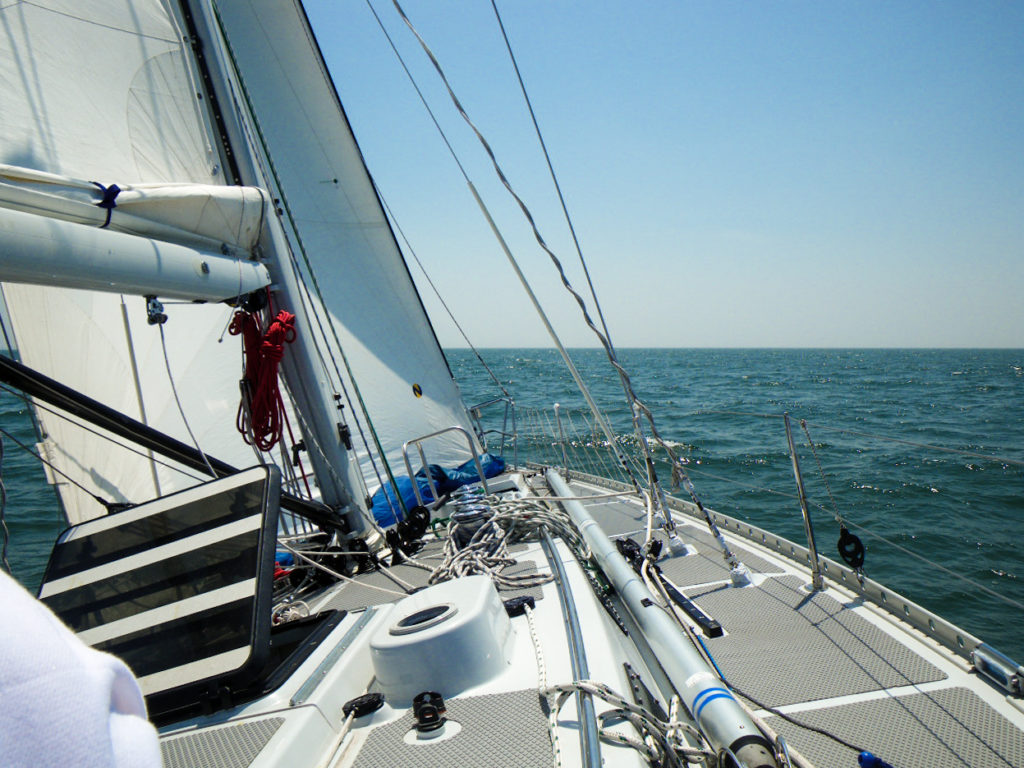
To know the ocean is to love the ocean. You have to, or else the trials you face out there would be too much. After my second year, we were sailing to Bermuda for a race. It was a week of tough, upwind sailing, across leagues of sea. One night we had left too much sail up as the sun set. During the night a storm began to surge and the wind grew in strength. We tried to avoid it, but it was eventually clear we’d have to undertake the dangerous task of changing our foresail to a smaller one. It was my job to lead the team forward and so forward we went. At night, with the storm raging, it was pitch black. The clouds covered the moon and any light from shore was hundreds of miles away. We struggled forward to the bow against the wind, and when we finally made it I looked ahead. The only light was from the thin line of phosphorescence at the top of the towering waves. I thought those waves looked like monsters in the night. Bracing as these beasts crashed down around us, again and again pinned as we fought for any grip to stay aboard, we grappled with the sail to try to heave it down and replace it. But in the dark, we could only barely manage.
To help, someone back aft turned on the deck light. This let us see but turned my whole world into only the five feet covered by the cone of light. Outside that we were totally blind, and more importantly I knew my crewmate driving the ship was blinded as well. This had me terrified. When the waves grow as big as they did in that storm, it is vital to guide the ship over the waves in just the right way. Otherwise, a sailboat careening down the backside of a wave will bury its bow in the trough, flipping the boat in a pitchpole. In a storm like this one, that would have been a death sentence. With no way to see, our helmsman would have to feel her way down the back of the waves, keeping us and the boat safe. She would have to rely on her own understanding of the sea, born of her own love and experience. Despite my terror I trusted her; she knew the waves, and she knew the ocean, and she steered us expertly through the storm while we changed the sail as quickly as we could. Morning came, and we were safe, but if our crew hadn’t understood the ocean we would have been doomed.
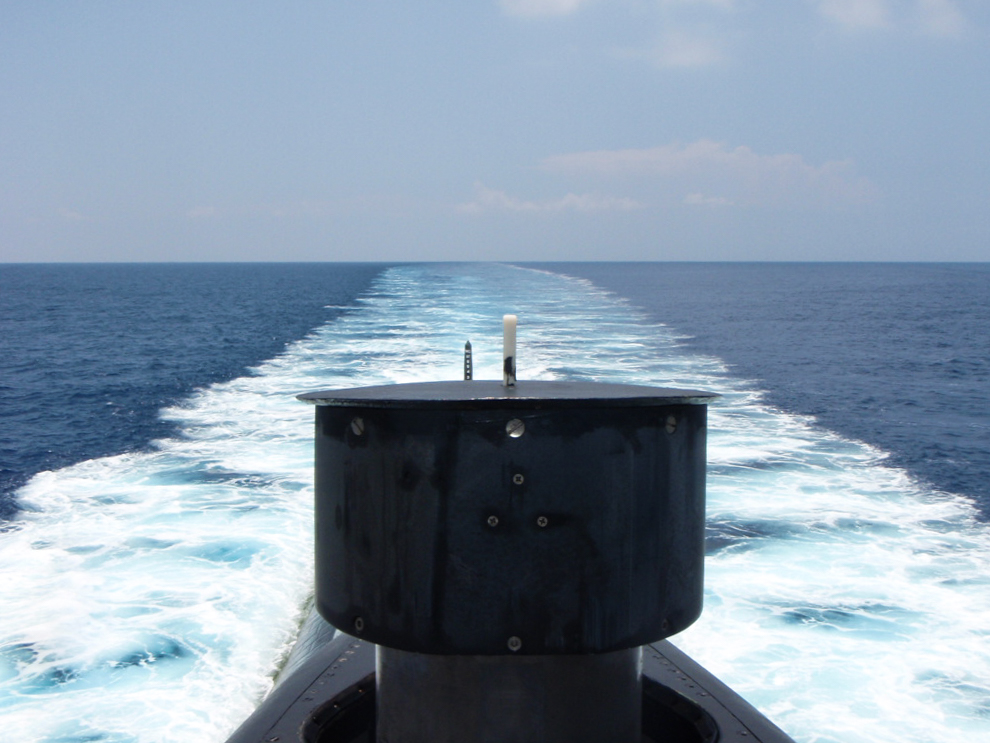
Fortunately, whatever the trials of storms and waves, the ocean makes up for it. It was on our return from Bermuda, and we were cruising along under a sunny blue sky. I looked up from the helm and over what had been an empty sea when suddenly we were surrounded by a pod of what seemed to be a hundred dolphins. They burst from one wave and soared through the air before diving into the next one. The played along our bow and jockeyed for position with each other. They swarmed and played and jumped and splashed and tittered all around until just as suddenly as they came, they were gone again. And so here out on the ocean I had found some small measure of perfection. I had a love of sailing and a love of the ocean. I was a member of a small crew who all understood our boat, the sea, and each other. And at that point I thought I was as close to the ocean as I ever could be.
As I approached my senior year at the Naval Academy, I had to choose a service community to join. Where to go? Drive surface ships? Fly planes? But when I looked around, the closest thing I saw to a sailboat was a submarine. On a surface ship, you cruise above the ocean. From the bridge 100 feet in the air, you overlook the waves and pride yourself on crashing through them, with the toughest sipping their coffee even as the barometer drops and the clinometers hit their stops. Above them, the people flying planes look down and pity those stuck only 100 feet up. But on a submarine, you don’t ride above the ocean, you’re in it. You’re enveloped in the sea, braving crushing depths but reliant on those same depths to keep you safe. When I first joined the sailing team, I never realized how close I would come to the ocean, but as I strode onto my first submarine, I could never have imagined how little I knew. Every aspect of the ocean and every change affects the submarine, down to the very way you float. Despite being submerged in it, in some ways in a submarine you are cooped up and away from the ocean – no matter where you are, the inside of the submarine is a nice cool 68 degrees and the weather never changes. But the ocean is never far away.
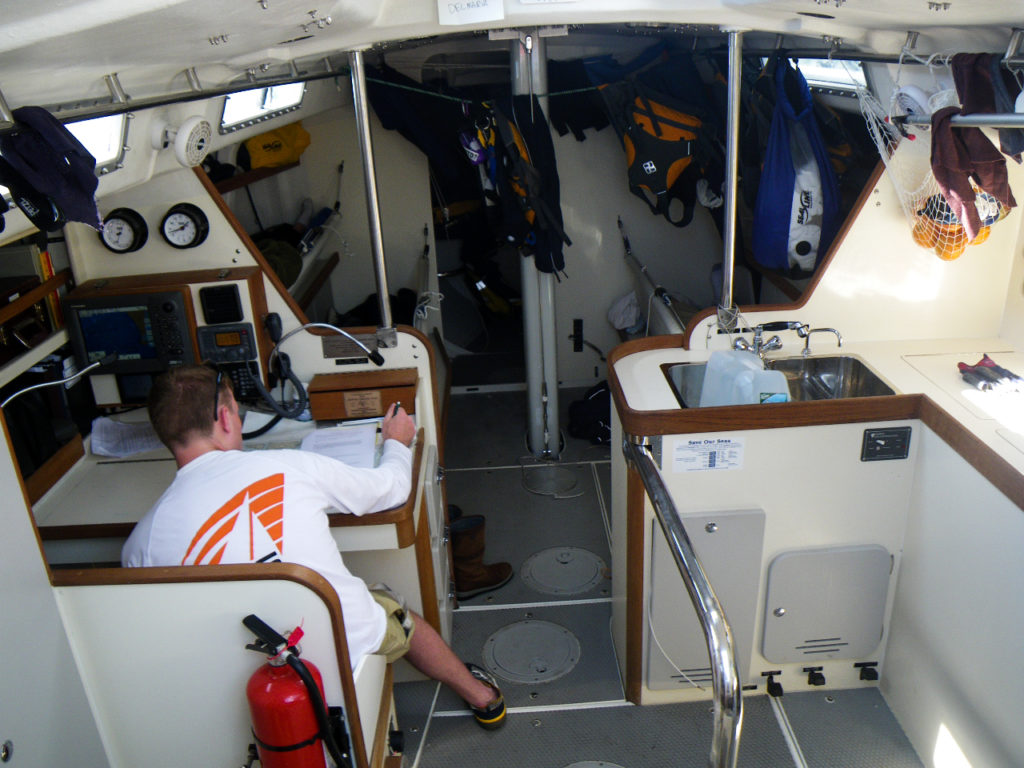
The trick when it comes to submarines isn’t to keep them afloat, but to make sure they sink just enough. A modern submarine is a 7,000-ton behemoth that powers through the deeps with the heat of a nuclear reactor. But it is a behemoth that needs to be neutrally buoyant, not a pound too heavy or a pound too light. The ocean isn’t a constant and the continually changing temperature and salinity affect the buoyancy of the boat. A hot day can evaporate the surface water and drive salinity up, and a rainstorm can dilute it and drive salinity down. Wave action will mix the water column and give you a constant gradient hundreds of feet deep, or calm seas can cause an inversion which means you suddenly get a lot lighter as you head towards the surface. Where rivers or springs empty into the ocean the swirling waters put the aft end of the ship in a totally different water column than the front.
Submarines are in many ways pretty fragile; they’ve already sunk, so to destroy them and everyone onboard you only need to sink them just a little bit more. Staying underwater and hidden is what keeps the submarine and crew safe and alive. Every person on the crew needs to understand the ocean, but the task of stepping through the dance falls to the small team of the helmsman and planesman. This is not easy; misunderstanding the waves and driving the submarine on a bad course could cause the ship to be sucked up and broach the surface. A good team, totally in sync, is marvelous to watch. The better they are they quieter they are, each with eyes locked on their gauges, responding to each other’s movements, feeling the effects of the sea on their actions from the tilt and rock of the ship.
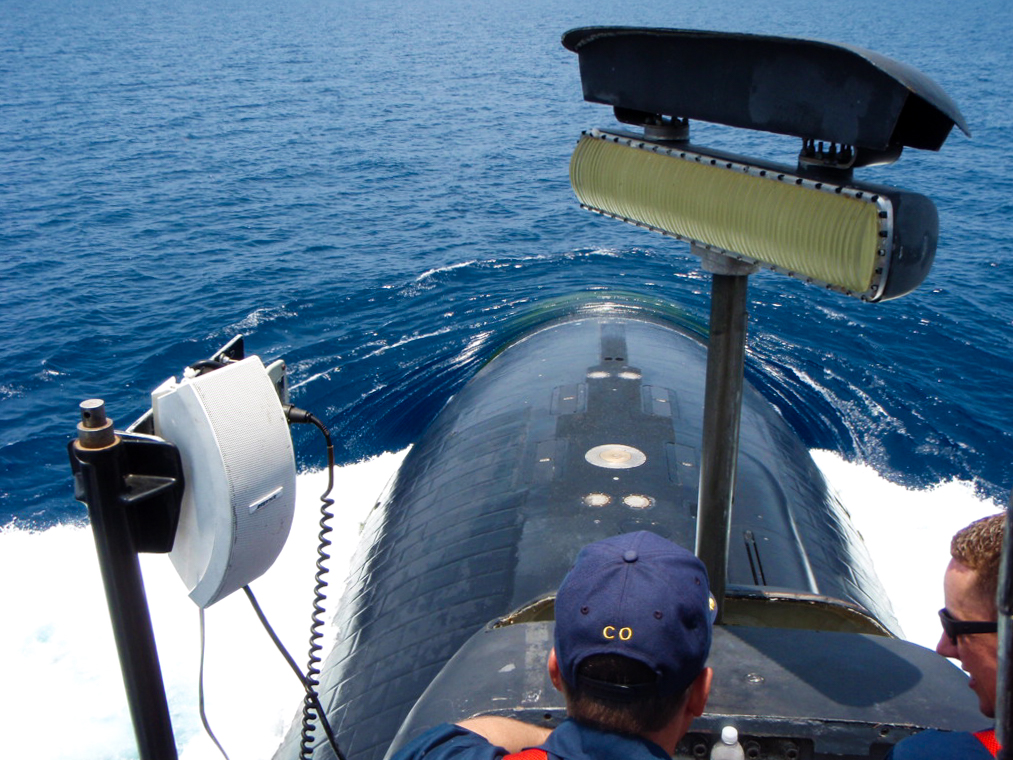
The most intimate connection to the sea on a submarine is through sounds. In the same way that I learned to see the wind, on the submarine I learned how to read the ocean from the sound. Sound is everything underwater. Without windows and without light, sound is the only way we have to navigate the world. Sonar is not like you see in the movies. Real sonar is passive, just listening to the sounds of ships and fish and waves to paint our picture of the world. Submarine sonar is incredibly powerful, with a supercomputer scraping the hydrophones for every scrap of sound energy. In the control room, we would always have on a hydrophone speaker, eavesdropping on the ambient sounds of the ocean. The sounds we were worried about were the gnashing, rattling crash of propellers from ships that could spell our doom. But while listening close for the sounds of danger you heard the ocean’s more secret voice. I always felt you could tell the ocean’s mood, listening to its anger in harsh whines and screeches. Most days the ocean was happy, usually quiet and content, or imbued with the low whoops and higher pitched whistles of whales. As you listened close and watched the sonar screens, you could begin to see the world around you. You could see the rainstorm, with its erratic trails passing down the starboard side and raindrops sounding close despite 400 feet of depth. You could watch the distant merchant ship, plodding along a well-worn route with the engine’s steady drumbeat. The loudest sound in the ocean is made by snapping shrimp. They’re so loud that a prudent submarine can hide behind these tiny shrimps to avoid detection. But on an average day their clicks and clacks were a soothing comfort from far away.
When my service was up, I was not sad to leave the submarine. Life onboard a submarine is stressful and hard. But I was sad to leave those moments onboard the bridge at night, with the warm air of the Java sea and the lights of fisherman along the horizon. I was sad to leave the quiet transits and the stormy trips to periscope depth. The best moments were those when we were true mariners, focusing all our efforts and all our love to keep the ship steady and on course. And after a long day I never slept better than in my bunk against the bulkhead, its thin hull the only thing between me and the sea.